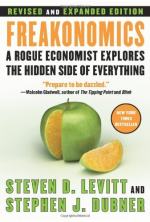
|
| Name: _________________________ | Period: ___________________ |
This test consists of 15 multiple choice questions and 5 short answer questions.
Multiple Choice Questions
1. How do teachers most often cheat on standardized tests?
(a) They allow children to have books out.
(b) They read the answers to the children.
(c) They never administer the test.
(d) They erase wrong answers.
2. According to Paul Feldman's records, when are people least honest?
(a) Early in the morning.
(b) During the winter.
(c) During holiday seasons.
(d) During tax season.
3. How many homeless people did Mitch Snyder tell a college class die every second?
(a) 25.
(b) 1.
(c) 45.
(d) 10.
4. Which two groups are the most discriminated against on Weakest Link?
(a) Blacks and asians.
(b) Indians and southerners.
(c) Women and the youngest contestants.
(d) Latinos and the elderly.
5. Which of the following real estate terms indicates that a home buyer should bid high?
(a) Granite.
(b) For sale by owner.
(c) Charming.
(d) Spacious.
6. According to the authors, what euphemism means that a house is largely dilapidated?
(a) Spare.
(b) Fixer upper.
(c) Well-maintained.
(d) Rustic.
7. To what organization do the authors immediately compare the Black Gangster Disciple Nation?
(a) The Ku Klux Klan.
(b) McDonald's.
(c) General Motors.
(d) The American military.
8. What Supreme Court case involved Norma McCorvey as plaintiff?
(a) Plessy v. Ferguson.
(b) Gibbons v. Ogden.
(c) Brown v. Board of Education.
(d) Roe v. Wade.
9. Which of the following is not a reason why crack was so appealing to urban gangs in the 1980s?
(a) It provides a fast, powerful high.
(b) It has a lower chance of overdose.
(c) It is less expensive.
(d) Its high fades quickly.
10. Within a single office, who cheats Paul Feldman most?
(a) Visiting employees.
(b) Executives.
(c) Custodial staff.
(d) Low level employees.
11. In what crime-ridden neighborhood did Venkatesh do his graduate research?
(a) South Central Los Angeles.
(b) South Chicago.
(c) East St. Louis.
(d) The South Bronx.
12. What event in California has allowed two Enron traders to jack up energy prices int he dialogue of this chapter?
(a) A plane crash.
(b) An earthquake.
(c) A wildfire.
(d) A heatwave.
13. According to James Alan Fox in 1995, what is the minimum rise in violent crime to be expected in the next decade?
(a) 15%.
(b) 35%.
(c) 25%.
(d) 5%.
14. How long does the Black Gangster Disciple Nation hold Venkatesh in the stairwell the first time he happens upon them?
(a) 2 hours.
(b) 24 hours.
(c) 15 hours.
(d) 8 hours.
15. What did the clan call its book of beliefs?
(a) The Kloran.
(b) The Klible.
(c) The Klagavaad Klita.
(d) The Klorah.
Short Answer Questions
1. Researchers determining whether teachers are encouraging cheating on standardized tests observe classes over how many years?
2. In summation, what does Levitt claim was the source of the Klan's power in the twentieth century?
3. Why does Levitt believe there are few violent criminals in the end of the twentieth century?
4. What unethical practice are Atlanta police discovered to have undertaken throughout the 1990s?
5. By what percentage did violent crime drop between 1995 and 2000?
|
This section contains 459 words (approx. 2 pages at 300 words per page) |

|




